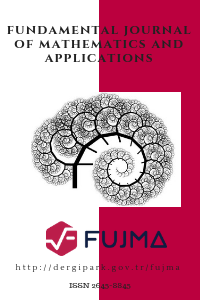Determination of Heterogeneity for Manganese Dendrites Using Lacunarity Analysis
Determination of Heterogeneity for Manganese Dendrites Using Lacunarity Analysis
___
- [1] T. G. Smith, G. D. Lange, W. B. Marks, Fractal methods and results in cellular morphology—dimensions, lacunarity and multifractals, J. Neurosci. Methods, 69(2) (1996), 123-136.
- [2] R. E. Plotnick, R. H. Gardner, W. W. Hargrove, K. Prestegaard, M. Perlmutter, Lacunarity analysis: a general technique for the analysis of spatial patterns, Phys. Rev. E, 53 (1996), 5461.
- [3] R. E. Plotnick, R. H. Gardner, R. V. O’Neill, Lacunarity indices as measures of landscape texture, Landsc. Ecol., 8(3) (1993), 201-211.
- [4] B. B. Mandelbrot, The Fractal Geometry of Nature, Times Books, 1983.
- [5] V. Mesev, Remotely Sensed Cities, CRC Press, London, 1-13, 2003.
- [6] A. Balay-Karperien, Defining Microglial Morphology: Form, Function, and Fractal Dimension, Charles Sturt University, Ph.D. Thesis, 86, 2004.
- [7] M. Bayirli, The geometrical approach of the manganitise compound deposition on the surface of manganisite ore, Phys. A: Stat. Mech. Appl., 353 (2005), 1-8.
- [8] C. Allain, M. Cloitre, Characterizing the lacunarity of random and deterministic fractal sets, Phys. Rev. A, 44 (1991), 3552.
- [9] Z. Merdan, M. Bayirli, Computation of the fractal pattern in manganese dendrites, Chin. Phys. Lett., 22(8) (2005), 2112.
- [10] Y. Gefen, Y. Meir, B. B. Mandelbrot, A. Aharony, Geometric implementation of hypercubic lattices with noninteger dimensionality by use of low lacunarity fractal lattices, Phys. Rev. Lett., 50(3) (1983), 145.
- [11] A. Roy, E. Perfect, W. M. Dunne, N. Odling, J.W. Kim, Lacunarity analysis of fracture networks: Evidence for scale-dependent clustering, J. Struct. Geol., 32(10) (2010), 1444-1449.
- [12] C. R. Butson, D. J. King, Lacunarity analysis to determine optimum extents for sample based spatial information extraction from high resolution forest imagery, Int. J. Remote Sens., 27(1) (2006), 105-120.
- [13] L. Wan, D. Xie, X. Hu, Study of local mineralized intensity using rescaled range analysis and lacunarity analisis, Engineering Science and Technology Review, 6 (2013), 105-109.
- [14] C.A. Scheneider, W.S. Rasband, K.W. Eliceiri, NIH Image to ImageJ: 25 years of image analysis, Nat. Methods, 9(7) (2012), 671-675.
- ISSN: 2645-8845
- Yayın Aralığı: Yılda 4 Sayı
- Başlangıç: 2018
- Yayıncı: Fuat USTA
On Predictors and Estimators under a Constrained Partitioned Linear Model and its Reduced Models
Melek ERİŞ BÜYÜKKAYA, Nesrin GÜLER
On the Bi-Periodic Mersenne Sequence
Gül ÖZKAN KIZILIRMAK, Dursun TAŞÇI
On the Exponential Diophantine Equation $(6m^{2}+1)^{x}+(3m^{2}-1)^{y}=(3m)^{z}$
Murat ALAN, Ruhsar Gizem BİRATLI
Pedal Sets of Unitals in Projective Planes of Order 16
Generalized Bertrand and Mannheim Curves in 3D Lie Groups
Osman Zeki OKUYUCU, Bahar DOĞAN YAZICI
Determination of Heterogeneity for Manganese Dendrites Using Lacunarity Analysis
Fixed Point Theorems in $\mathscr{G}$ - Fuzzy Convex Metric Spaces
